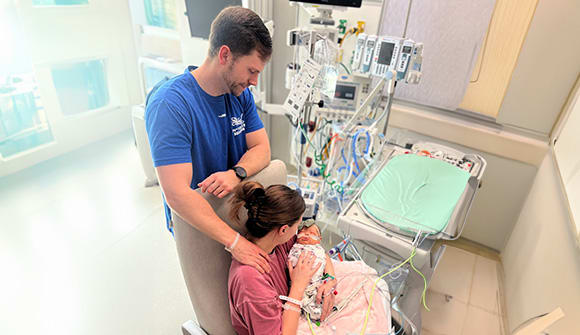‘Where we needed to be’
Georgia infant makes full recovery after rare heart defect diagnosis.
Article Date:

In January 2024, when one-week-old Remi Nix suddenly stopped eating, her mother, Elizabeth Nix, did what any parent would do and rushed Remi to her pediatrician.
“When we got there, I opened the car to get her from the car seat, and she was hardly breathing and was blue,” Elizabeth recalled.
Remi, who lives in Valdosta, Georgia, was rushed by ambulance to a nearby hospital. After she arrived, her condition rapidly declined; her heart and breathing stopped. Providers administered CPR for four minutes to revive her, and she was placed on a ventilator.
Soon after, the decision was made to transfer Remi to Wolfson Children’s Hospital of Jacksonville by Kids Kare helicopter, but a tornado warning prevented the aircraft from flying. Instead, Remi was transported to Jacksonville in the Kids Kare Mobile ICU.
The family knew Remi had a heart murmur, which was discovered at birth, but no one knew what was causing her sudden decline. Once Remi arrived at Wolfson Children’s, testing showed a massive difference between her upper and lower blood pressure numbers, which increases the chances of a cardiac-related event.
“Due to the lack of blood flow, her kidneys and liver were damaged. She was in very critical condition when she arrived in Jacksonville,” said Daniela Neagu, MD, a pediatric cardiologist.
Diagnosing a congenital heart defect
Dr. Neagu ordered an echocardiogram, and it was discovered that Remi had coarctation of the aorta (COA), a congenital heart defect in which a part of the body’s largest artery (aorta) is narrower than usual. The condition can cause heart failure and puts organs at risk due to lack of blood flow.
In infants, symptoms of a congenital heart defect, like COA, include trouble breathing, poor weight gain and an inability to feed, as Remi experienced in January, because feeding is how babies use most of their energy.
Remi was transferred to the Cardiovascular Intensive Care Unit (CVICU) in the Borowy Family Children's Critical Care Tower, where she was given medication to restore blood flow to her organs. She stayed for about a week as her body healed in preparation for surgery.
“I knew at that time, the only thing that was going to help her would be surgery,” Elizabeth said.
How common is COA?
Michael Shillingford, MD, MBA, repaired the narrowed segment of the aorta. Remi was transferred back to the CVICU following her surgery and made a full recovery.
“While COA isn’t common in the general population, the Terry Heart Institute is a regional referral center for patients with congenital heart defects, and as a result, we see this diagnosis fairly frequently,” Dr. Shillingford said.
Remi stayed in the CVICU for another week and a half before returning home to Georgia. Since the surgery, she has steadily improved and is a perfectly healthy baby, Elizabeth said.
Though the experience was scary and emotional, Elizabeth said her family could not have been in a better place than Wolfson Children’s.
“It was exactly where we needed to be,” she said. “You could tell Remi was their number one priority. We were always in the loop, and her care team was knowledgeable and friendly. I truly believe Wolfson Children’s has some of the best doctors and nurses in the world.”
The pediatric cardiology, electrophysiology, imaging, cardiac intensive care, cardiac anesthesiology and heart surgery teams with Wolfson Children’s C. Herman and Mary Virginia Terry Heart Institute treat a full range of pediatric cardiac conditions, from defects present at birth to heart rhythm disorders. To learn more, call 904.202.8550 or visit wolfsonchildrens.com/heart.



